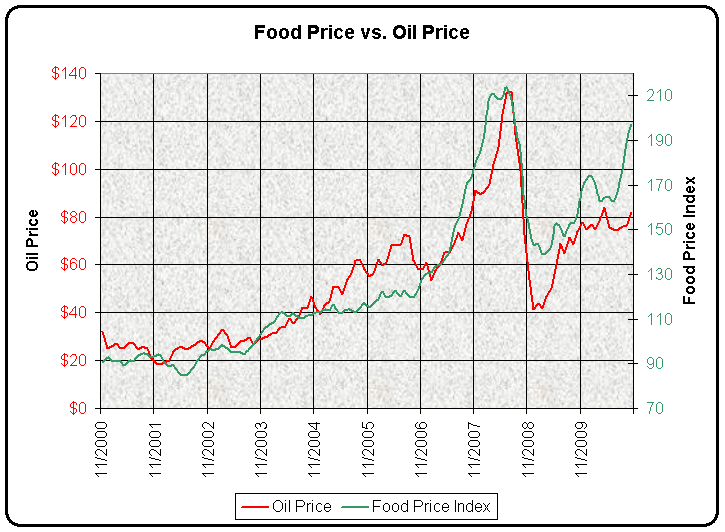How many CPG? - Cows per gallon, that is
Greetings Peaksters
There's a bunch of food in the news this week. I heard an interesting interview with Lester Brown where he discussed the "Food Bubble". Not that the price has been bid up to unsustainable heights, like the housing bubble. But that the _ amount_ of food available is unsustainable. That we have reached the limit of arable land and water. He's been watching the grain market for decades, and in the past every time the price rose, farmers responding by bringing additional acres into production. He doesn't think that's possible this time. http://www.ecoshock.info/
He mentions one energy-food connection, that of ethanol, where the (subsidized) price of ethanol is causing 1/4 of the corn production to be taken off the food market. Another interesting connection is the situation in North Africa, where the citizens are rioting (in part) because of high food prices. What if those political actions affected the flow of oil? see http://earlywarn.blogspot.com/2011/01/oil-food-and-wealth-of-mena-countries.html#more
" The ultimate nightmare would be a sort of vicious feedback loop in which high food prices cause turmoil in oil exporting nations thus reducing oil production, causing an oil price spike, which in turn would feed back into even higher food prices as farmers had to raise prices to cover their input costs and biofuel production was rendered more profitable."
And speaking of the costs of inputs. What about that cheese burger?
Oil and food prices
by Jason Bradford
(1 vote)
Several years ago National Geographic magazine published an article on oil that included a stunning photo of mature steer and the barrels of oil needed to grow an animal to that size. I recently went looking for that picture, found it, and post it here because it hasn’t lost its impact or relevance one bit.

Here’s the caption that accompanies that photo:
Weighing in at 1,250 pounds (567 kilograms), Marina Wilson’s champion steer Grandview Rebel is ready for auction at a county fair in Maryland. Raising this steer has taken an agricultural investment equal to 283 gallons (1,071 liters) of oil, represented here by the red drums. That includes everything from fertilizers on cornfields to the diesel that runs machinery on the farm. Overall, it takes three-quarters of a gallon of oil to produce a pound of beef.
Yowza! Three quarters of a gallon of oil to produce a pound of beef. At $4.00 per gallon, this implies the cost of a pound of beef includes $3.00 worth of oil.
In reality, the oil is used for illustrative purposes only. The energy in the food systems comes from many sources, such as natural gas for fertilizer and drying grains, and the electric grid for almost everything. Broadly, however, industrial energy sources tend to have correlated prices and oil is considered the lynch pin since it is involved in the transportation of all goods, including energy inputs.
Given the heavy use of oil in the food system wouldn’t you expect oil and food prices to correlate? Well they certainly do.

The above graph comes from the web site of Paul Chefurka and derives from easy to get, publicly available data from the UN Food and Agriculture Organization and the US Energy Information Agency.
The Broad Context
While the price correlation is stunning, the big picture is even more interesting. Let’s look at this again from an energy perspective by comparing the energy content of one pound of meat with the 3/4 gallon of oil that goes into it. 3/4 gallons of oil is equivalent to 0.11 Giga Joules (GJ) of energy. A pound of meat averages about 1000 kilo calories, which equals a measly 0.0042 GJ.
Twenty six (26) units of fossil fuel energy goes into producing one (1) unit of food energy in the form of beef.
Agriculture was created as the primary way civilizations harness the energy that allows them to do work. Now, however, agriculture is simply another fossil fuel conversion system. While these fuels provide us with tremendous labor efficiency, we can no longer say we have an energy efficient way to make food since food production is now an energy sink.
Given the volatile and generally rising trends in energy costs, I believe we are in a transition between two periods. For the past several decades, fossil fuels could be counted on as readily available and cheap, which is what built the system we have. These non-renewable stocks have depleted to the point where we may no longer get the historic rates of flow we’ve depended on. Look ahead a bit then, and an advantage goes to systems that build renewable stocks and capture and convert renewable flows of energy.
In simple terms, this defines the need for sustainable agriculture. The renewable stocks we need to build include fertile topsoil. And the flows come from what plants, animals, fungi and microbes do with soil, water and sunlight.
Well, that’s the big picture. And if you want to learn the details of how this is done then this blog will be a worthwhile read.

0 Comments:
Post a Comment
Subscribe to Post Comments [Atom]
<< Home